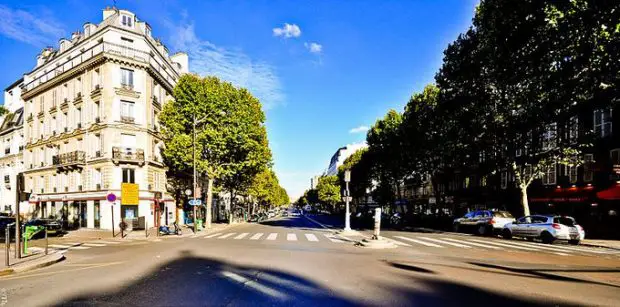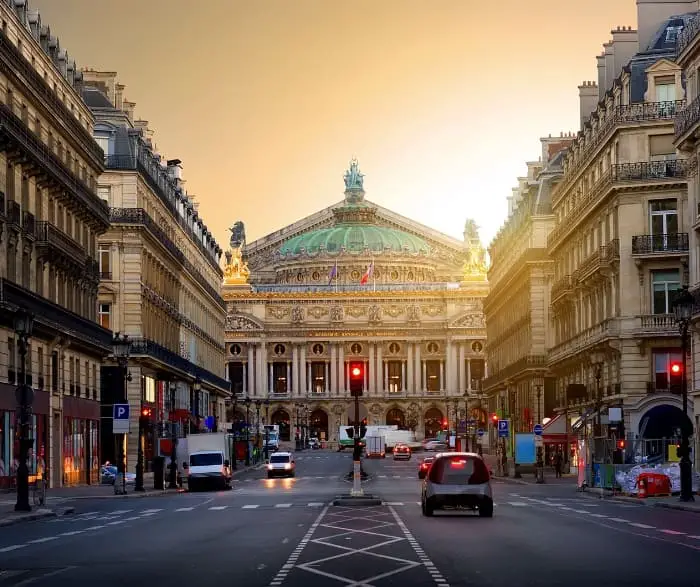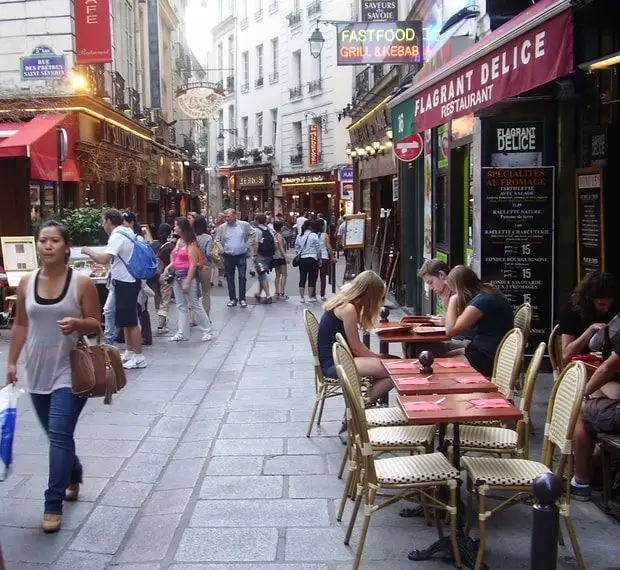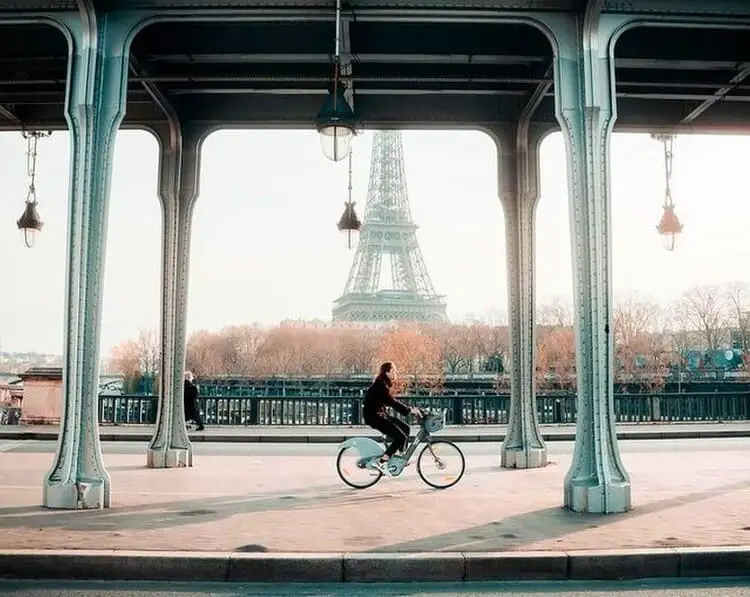This iconic Parisian hill, famous for its winding streets and picturesque staircases, has a lot to offer. Here’s my selection of the best spots in and around Montmartre.
Let’s start with a map:
Want a version of this map you can print or save on your phone?
I’ve created a pack with 13 one-page neighborhood maps—including this one. Each map comes with a quick guide and a QR code that links back to the full guide and the custom Google Map. Perfect for trip planning or exploring on the go.
Sacré Coeur Basilica
35 Rue du Chevalier de la Barre, 75018 Paris
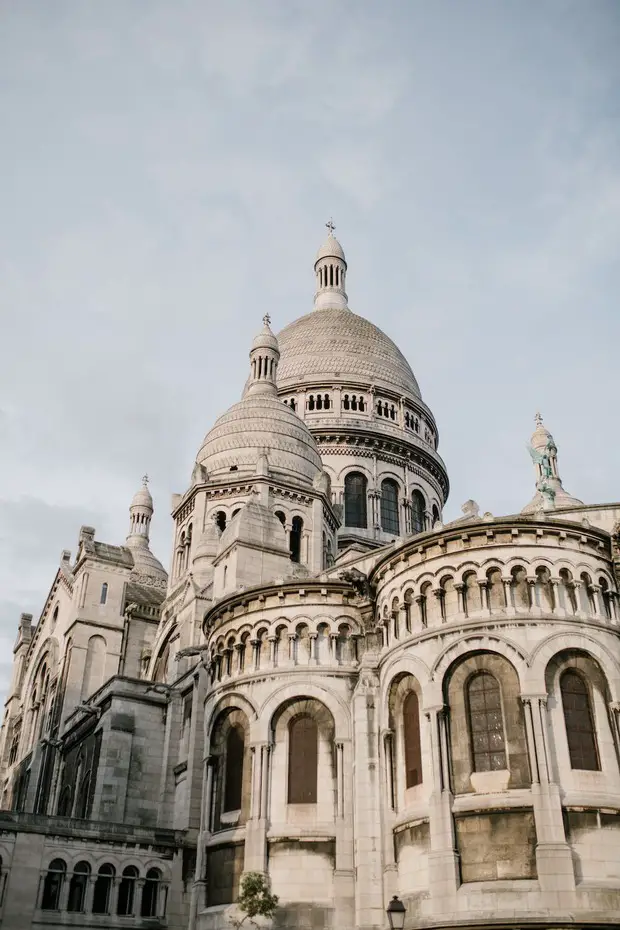
To discover the Basilica, you can either take the stairs or the funicular, a small carriage that brings you to the top of the Montmartre hill with a metro ticket or a Navigo pass.
At the top, a panoramic view of all Paris awaits you: the perfect opportunity to take photos and admire the city from this unique viewpoint.
I love: the EPHREM guest house: this establishment, right next to the Sacré Coeur, is a Catholic religious guest house open to all.
Find out more about the Sacré Coeur
Moulin Rouge
82 Boulevard de Clichy, 75018 Paris

The Moulin Rouge, the world-famous cabaret with its iconic red windmill, has been entertaining audiences since 1889.
Known for its spectacular can-can shows and glamorous costumes, it’s a staple of Parisian nightlife.
While tickets can be pricey, the experience of watching a show in this historic venue is truly unique.
I love: the historic ambiance and dazzling performances.
Info/booking: Moulin Rouge
Staircases of Montmartre
Throughout Montmartre
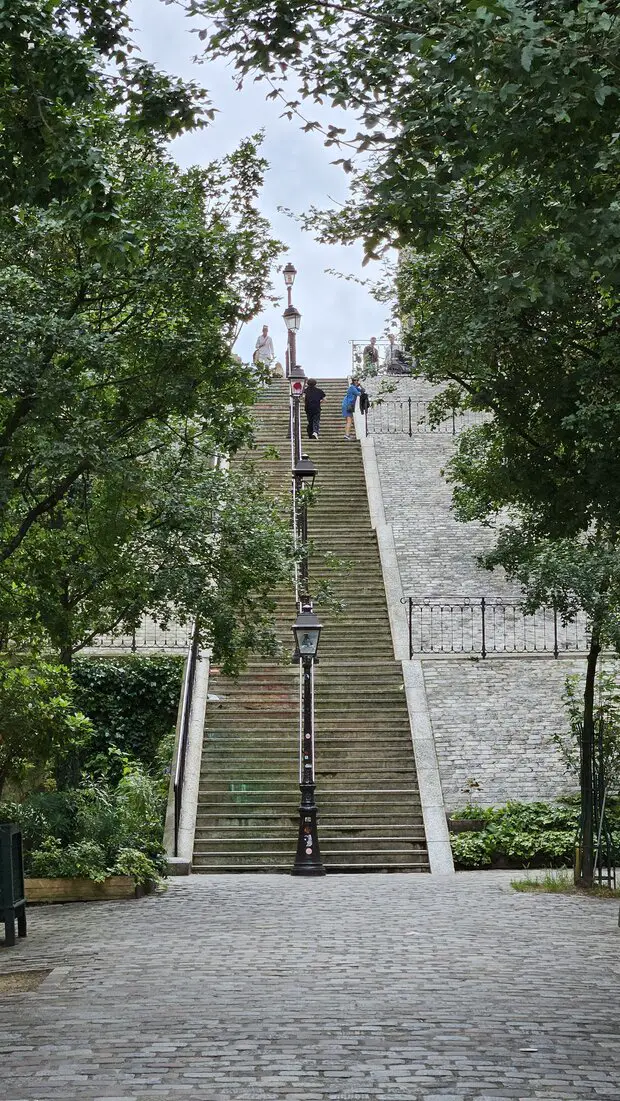
Montmartre’s charming staircases, like those of the Rue Foyatier, wind through the hills and offer stunning views of Paris.
These picturesque steps are ideal for a leisurely stroll and perfect for photography, with each staircase revealing new angles and views of the neighborhood.
I love: the views from the top and the sense of adventure of climbing through the neighborhood.
Explore my favorite 11 Montmartre’s staircases
Place du Tertre
Pl. du Tertre, 75018 Paris
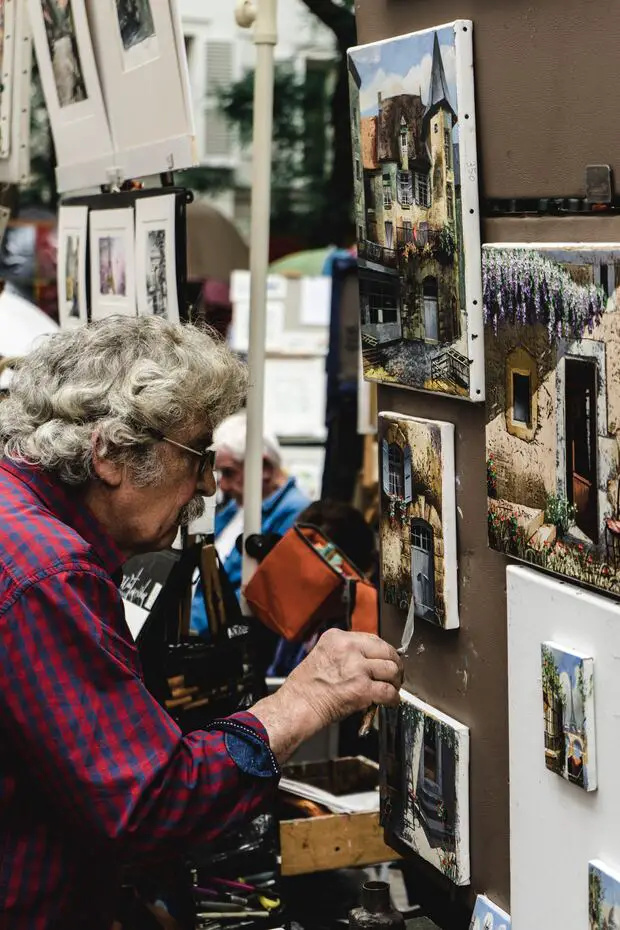
This lively square gathers many artists specializing in portraiture,
You’ll discover a variety of artistic techniques such as drawing, painting, caricatures and sketches.
As you sit at one of the cafés or take a walk, you can relax and watch the works of art come to life, or even have your portrait painted.
I love: the lively, inspiring setting.
Visit the Place du Tertre
Marcel-Bleustein-Blanchet square
1 Rue de la Bonne, 75018 Paris
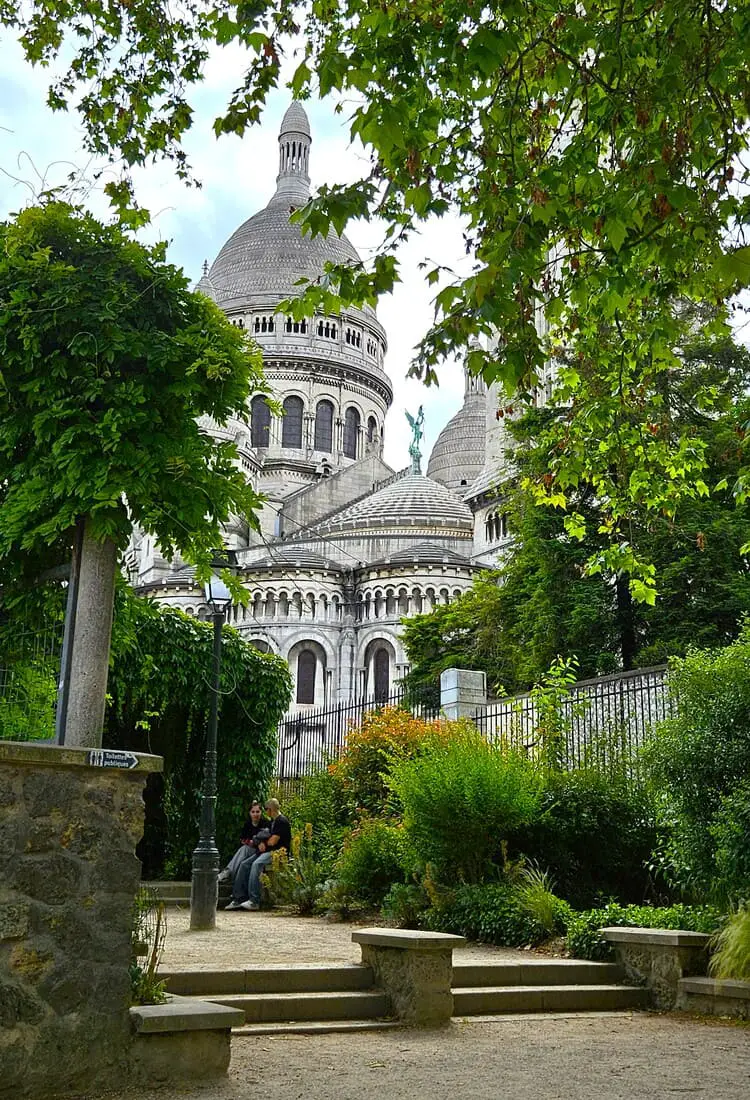
This square is located at the opposite end of the Sacré-Coeur square, away from the crowds of tourists who visit this famous basilica. To get there, simply walk around the Sacré-Coeur.
It’s the ideal place for those seeking peace and quiet to visit Montmartre without feeling overwhelmed by the crowds.
This spacious, green area is perfect for picnics or walks.
I love: its calm atmosphere in such a lively district.
Au Lapin Agile
22 Rue des Saules, 75018 Paris
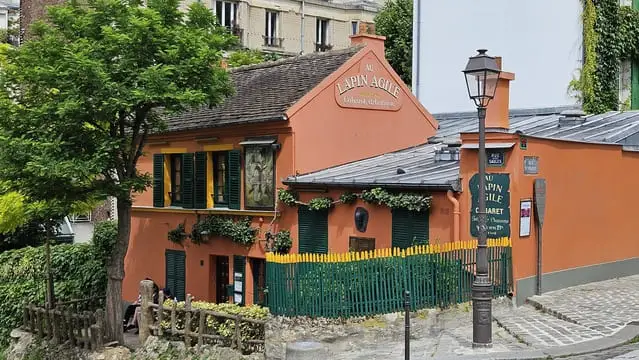
This cabaret, which celebrates French poetry and songs, is one of the oldest cabarets in Paris. Indeed, it was in 1969 that the place became “le cabaret des assassins [the murderers’ cabaret]”.
You’ll be seduced by the appearance of this place, a small pink countryside house that stands out from the surrounding buildings.
What’s more, this cabaret is an excellent alternative to expensive Parisian cabarets such as the Moulin Rouge, which cost almost three times as much as the Lapin Agile to patronize.
I love: the artist and singer Amala Landré
Moulin de la Galette
83 Rue Lepic, 75018 Paris
Voir cette publication sur Instagram
This historic windmill, immortalized by painters like Renoir and Van Gogh, is one of the last two remaining in Montmartre.
Originally a mill for grinding flour, it later became a lively dance hall for Parisians in the 19th century.
Today, it’s a restaurant, serving traditional French cuisine in a charming setting.
I love: dining in such a historic and artistic spot.
Find out more about the Moulin de la Galette
Le Cabanon de la Butte
16 Rue Gabrielle, 75018 Paris
Voir cette publication sur Instagram
This cozy little café is known for its warm atmosphere and stunning views of the Sacré-Cœur.
Le Cabanon de la Butte is the perfect spot for a break with coffee or a glass of wine while soaking in the ambiance of Montmartre.
It’s small and charming, making it feel like a hidden gem amidst the bustling area.
I love: the intimate feel and scenic view.
Discover Le Cabanon de la Butte
Espace Dali
11 Rue Poulbot, 75018 Paris (4-minute walk from the Sacré Coeur)
Voir cette publication sur Instagram
The Espace Dali is a place dedicated to the art and world of Salvador Dali, a Catalan painter, sculptor, engraver, screenwriter and writer.
Over 300 surrealist works of all kinds are on display, ranging from paintings to sculptures and prints.
Some of these works are even available for sale.
I love: the sculpture “la vision de l’ange”.
Visit the Dali Paris
Musée de Montmartre
12 Rue Cortot, 75018 Paris
Voir cette publication sur Instagram
If you’re passionate about art and history, I suggest you visit the Montmartre Museum. Set in a former manor, this museum has a unique style.
One of its major assets is the magnificent Renoir gardens that surround the museum.
Dynamic, the museum organizes exhibitions and cultural events all year long.
Visit the Montmartre Museum
Wall of Love
Square Jehan Rictus, Pl. des Abbesses, 75018 Paris
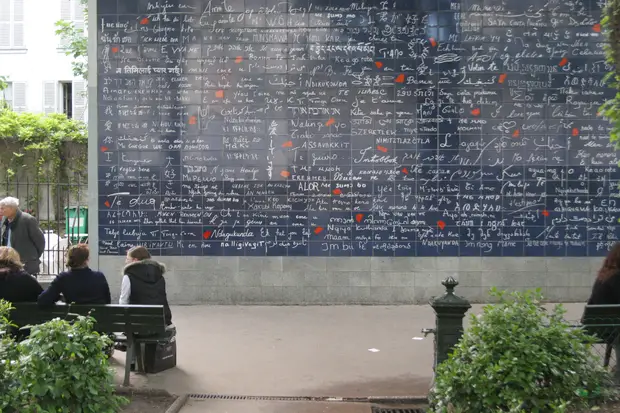
Located in a green area, this place offers a romantic atmosphere.
During your visit, you’ll have the opportunity to admire a unique blackboard, decorated with thousands of : “Je t’aime” (“I love you”).
This symbolic monument, which covers an area of 40 m², embodies the idea of reuniting a humanity that is sometimes torn apart. You’ll be amazed to see these words of love translated into almost 250 different languages.
I love: the love words written in ancient dialects.
Rue de l’Abreuvoir
Rue de l’Abreuvoir, 75018 Paris

Rue de l’Abreuvoir, often called one of the most beautiful streets in Paris, is known for its cobblestone charm, classic Parisian buildings, and colorful ivy-covered facades.
At the end of the street, you’ll find La Maison Rose, a famous pink café that’s a favorite photo spot.
Strolling here feels like stepping back in time, and it’s a quiet spot away from the crowds of Montmartre. Perfect for capturing picturesque photos, especially in the early morning light or during sunset.
I love: the romantic, postcard-like atmosphere of this hidden gem.
La Maison Rose
2 Rue de l’Abreuvoir, 75018 Paris
Voir cette publication sur Instagram
La Maison Rose is a charming establishment offering meals throughout the day and a brunch service at weekends.
The restaurant’s appearance changes according to the season and has a diversified menu.
In summer, you’ll be amazed by the profusion of greenery that covers the facade of the buildings just behind the restaurant.
In autumn, this greenery, still present, begins to turn red, orange, and brown.
Finally, in winter, only bare branches will climb up the façade.
I love: the street on which it’s located, which has a real charm all of its own.
Rue Saint-Rustique
Rue Saint-Rustique, 75018 Paris
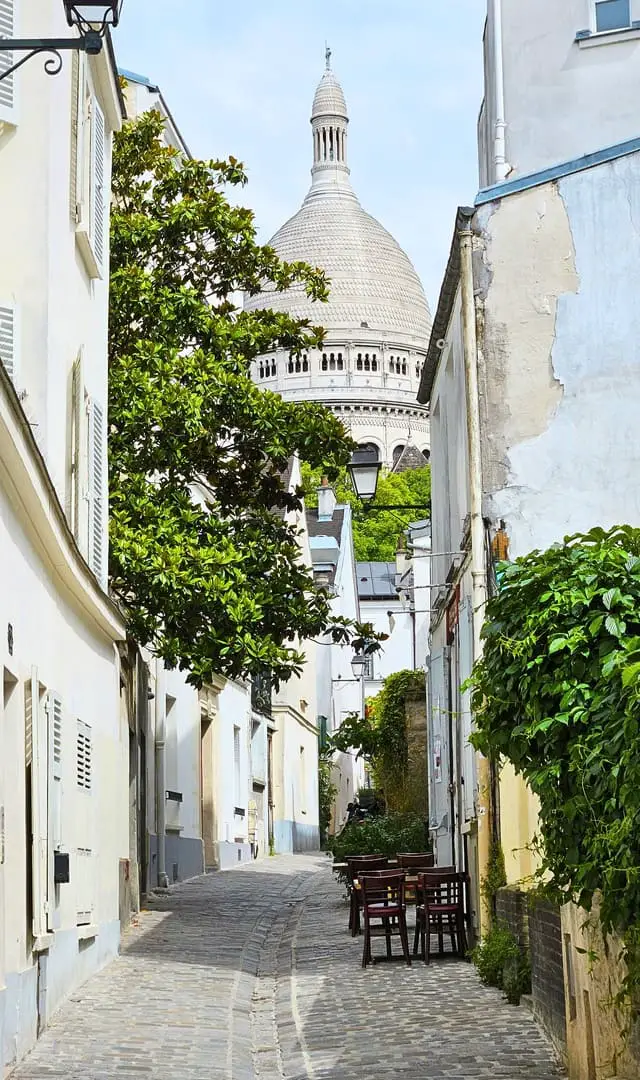
Rue Saint-Rustique is one of the oldest and most charming streets in Montmartre.
Its cobblestone path and picturesque buildings give you a real sense of old Paris.
This narrow, quiet street is less crowded than some of Montmartre’s busier spots, making it ideal for a peaceful stroll and beautiful photos.
You’ll find historic cafés and shops here that capture the spirit of the area.
I love: the serene vibe that feels like a step back in time.
Le Consulat
18 Rue Norvins, 75018 Paris
Voir cette publication sur Instagram
Le Consulat is a famous café in Montmartre that’s been a gathering place for artists and writers for decades.
Known for its red-and-white facade, this historic café feels like a postcard and serves classic French dishes.
Many famous painters like Picasso and Monet used to come here.
Today, it’s a popular spot for both locals and tourists to enjoy a coffee or a meal while soaking up Montmartre’s artistic history.
I love: the café’s history and classic Parisian ambiance.
Halle Saint-Pierre
2 Rue Ronsard, 75018 Paris
Voir cette publication sur Instagram
The Halle Saint-Pierre is a unique space that includes a museum, a gallery and a bookshop.
Housed in a former market, it’s the ideal place to immerse yourself in reading or to discover new works of art.
In addition, a tea room is at your disposal. You’ll be able to relax and exchange ideas in this inspiring place.
I love: different art forms to suit every taste
Le Refuge des Fondus
17 Rue des Trois Frères, 75018 Paris
View this post on Instagram
The Refuge des Fondus is a restaurant that serves its customers along at two long tables, which you have to step over to take a seat against the walls. This peculiar layout always causes a few laughs.
Over the decades, the interior walls have been covered in graffiti by customers, giving the place even more personality.
You can enjoy a meat or cheese fondue, accompanied by an aperitif, wine served in bottles and dessert.
I love: Wine served in baby bottles, a unique experience.
Le Passe-Muraille
Place Marcel Aymé, 75018 Paris
Voir cette publication sur Instagram
Inspired by the character from Marcel Aymé’s story Le Passe-Muraille (The Man Who Walked Through Walls), this quirky sculpture depicts a man half-emerged from a wall.
Created by artist Jean Marais, it’s a playful and curious sight that adds a touch of magic to Montmartre.
I love: the whimsical, unexpected nature of this sculpture.
La Crémaillère 1900
15 Pl. du Tertre, 75018 Paris
Voir cette publication sur Instagram
La Crémaillère 1900 is a classic French brasserie with a vintage Parisian charm, located in the heart of Place du Tertre.
With its Belle Époque decor and garden terrace, it’s the ideal spot to soak in Montmartre’s artistic atmosphere.
The restaurant serves traditional French dishes, such as escargots, beef bourguignon, and crème brûlée, making it a go-to for those wanting an authentic taste of Paris.
I love: the beautiful garden terrace and live music that adds to the warm ambiance.
Saint-Pierre de Montmartre church
2 Rue du Mont-Cenis, 75018 Paris
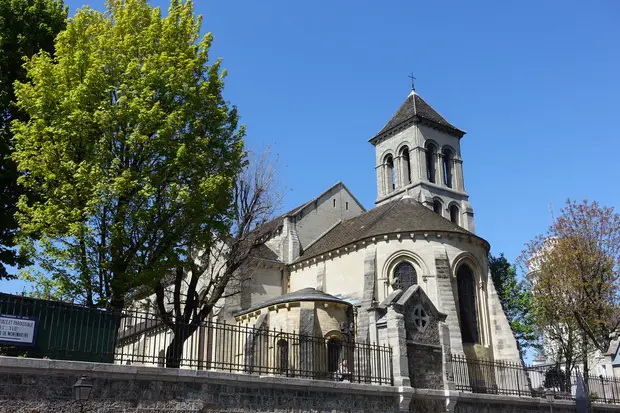
The Saint-Pierre de Montmartre church, also known as Saint Jean des Briques because of its exterior decoration, is one of the oldest churches in Paris.
Unlike some of the other tourist sites in the area, it is rarely crowded, which is a valuable advantage in such a lively neighborhood.
The church’s interior is uniformly sober and beautiful, but the colorful stained glass windows flood the space with light and add a touch of color.
I love :
- its Romanesque architecture
- its peaceful atmosphere.
Café des Deux Moulins
15 Rue Lepic, 75018 Paris
Voir cette publication sur Instagram
The Café des deux moulins is famous and emblematic in the Montmartre district for its important role in the movie Le Fabuleux Destin d’Amélie Poulain.
So, as you sit down at a table in this café, you’ll be immersed in a true movie set.
You can also enjoy typical French dishes at this restaurant, which offers a selection of formulas, starters, main courses, desserts and drinks.
I love: The recognizable movie set elements everywhere in the café.
Bouillon Pigalle
22 Bd de Clichy, 75018 Paris
Voir cette publication sur Instagram
The Bouillon Pigalle is a classic. It’s a restaurant offering high-quality traditional French cuisine.
It offers a selection of starters, main courses and desserts, accompanied by a variety of alcoholic and non-alcoholic beverages.
Among the menu’s top dishes, onion soup and boeuf bourguignon are must-tries.
I love: once you’re seated, it’s like stepping back in time.
Vineyards of Montmartre
14 Rue des Saules, 75018 Paris France
Voir cette publication sur Instagram
This is a place that will completely transport you to another world. Forget for a moment that you’re in Paris, because this is where you’ll find the vineyards of Montmartre.
Yes, vineyards in Paris. These 1070-year-old vines cover an area of 2000m².
They are among the last remaining in Paris, which makes them a rare sight.
I love: immersing yourself in a unique place steeped in history, right in the heart of Paris.
Rochechouart Hotel Rooftop
55 Blvd Marguerite de Rochechouart, 75009 Paris
Voir cette publication sur Instagram
This rooftop, located on the ninth floor of the building, offers a breathtaking view of the Sacré Coeur. It’s definitely one of the best rooftops in Paris.
Although prices at this bar are slightly higher than at other establishments, the view is well worth the expense.
As well as drinks, the bar also offers a delicious selection of dishes.
I love: the “chilcano” cocktail: the fruity notes of Pisco and Pama blend well with the acidity of lemon.

With a passion for travel and having visited over 50 countries, Dorian is eager to share his favorite spots and expert tips to help you explore Paris and France like a local.

